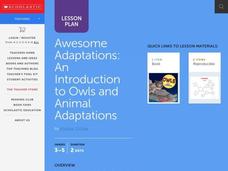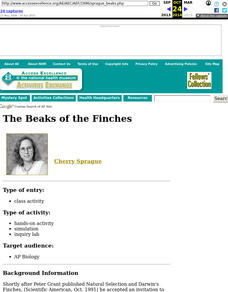Curated OER
Bird Beaks and Feet
In this bird adaptations activity, students look at different bird pictures and determine what the bird eats and where it lives by looking at its beak and feet. Students complete a graphic organizer and 5 short answer questions.
Scholastic
Awesome Adaptations
Engaged learners discover how an owl beak works and how animals adapt to their environment. This task is part one of a three-part series.
Curated OER
What Makes A Bird A Bird?
Students identify the characteristics of birds and explain how these characteristics are useful in their survival. They explain how both physical and environmental adaptations help birds survive and reproduce. Students create an...
Curated OER
Activity: Bird Beak Buffet
Students study the functions of bird beaks. In this animal evolution lesson, students compare and contrast different types of bird beaks focusing on how the beaks are adapted to the foods the birds eat. Students record and graph their...
Curated OER
Exploring the Uses of Beaks
Pupils explore the uses of bird beaks in the wild by participating in experiment stations. In this bird adaptation lesson, students work in groups and complete experiment stations that represent different types of bird beaks. Pupils...
Curated OER
The Birds and the Beaks
Students explore the adaptations that birds have. In this adaptations lesson plan students view a video and create a concept map of birds and their adaptive traits.
Curated OER
Sunken Lesson: Animal Adaptation
This animal adaptation PowerPoint provides definitions and photographs of vocabulary related to how the animals that live in particular biomes protect themselves. It also explains the cause/effect relationship between the inability of...
Curated OER
The Beaks of the Finches
Students become birds and are given "beak-types". After completing the simulation, students relate results to adaptations and natural selection. Extensions of the simulation allow for comparative results and include population genetics.
Curated OER
Bird Bodies
Students read about and explore the different types of birds. They discuss how all birds are alike and what makes some different from the others. They experiment picking up "food items" using different tools that represent different...
Curated OER
All About Birds
In this birds worksheet, students answer 25 short answer questions about birds. They color and label the different parts of a bird and fill in the correct term given the definitions.
Curated OER
Bird Land
Students role-playing the concept of evolution through naturally occurring mutations. Working in pairs, they model how birds have adapted to the food sources in their environment through changes in their beak size and shapes. Students...
Curated OER
Compare Human-made Objects with Natural Objects
Learners examine and observe how many human-made objects get their basic design from things in nature. They listen to the book "Nature Got There First," compare/contrast hollow bones with drinking straws, bird beaks and tool pliers, and...
Curated OER
Penguins Around the World
Young scholars investigate penguins. In this Science lesson, students compare and contrast penguins to flying birds. Young scholars use a Venn diagram to illustrate the differences and similarities of penguins and flying birds.
Curated OER
Dancing Flamingos
Young scholars perform a number of activities that mimic flamingo actions and displays. The class discusses why animals behave in certain ways, and how behavioral adaptations help animals to survive.
Curated OER
Amazing Bird Adaptions--Why Am I A Bird?
Fourth graders identify and classify birds found in Illinois. Using the internet, they discover how birds have adapted over time and how the adaptations have increased their life span. They compare and contrast the various adaptations...
Curated OER
Fill The Bill
Students identify and describe five different types of beaks. Using that information, they explain how each of them is adapted to feed on different foods. In groups, they travel around the room to various stations in order to practice...
Curated OER
Adaptations of the Beak
Students examine the principles of adaptation using mouth structure of animals as an example. Students look specifically at the various shapes of beaks of birds and the bill of the platypus.
Curated OER
Bird Beak Anatomy
Third graders participate in an activity to determine which tool will work the best to gather food. They create analogies about how the experiment relates to birds. They brainstorm about which adaptation helps or hurts the survival of an...
Curated OER
Seabird Survival Adaptation Card Game
Students study seabirds and how they have adapted to their environments. In this activity based lesson students will play a card game that will allow them to have a better understanding of seabirds and their adaptations.
Curated OER
Birds Learning Cycle Lesson Plan
Ninth graders explore the various adaptations of birds and compare differences and similarities of different birds.
Curated OER
Snowy Owl Adaptations
Pupils explore the adaptations that are made by the snowy owl. They discuss why these adaptations are necessary and how they protect the owl. Students create a snowy owl puppet.
National Park Service
Nutcracker Fantasy
The Clark's nutcracker bird hides seeds in 25,000 different sites every year to save for winter. Lesson demonstrates how difficult it would be to find these seeds months later when they need them for food. In the first of five lesson,...
Curated OER
It's For the Birds
Fifth graders examine how anatomical adaptations make it possible for a bird to survive in various habitats. They discuss and list birds and their unique characteristics, and create an imaginary bird, illustrating the environmental...
Curated OER
Clipbirds
Students attempt to pick up various objects with a wide variety of beaks, including scissors, spoons, etc.

























